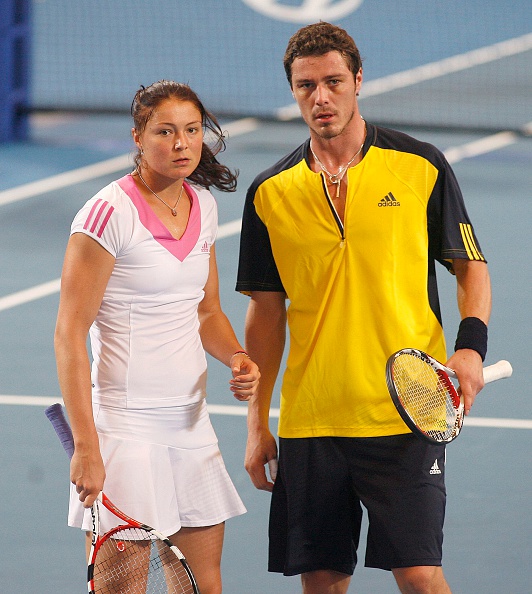Wading through the sea of champions set to be featured at the International Tennis Hall of Fame Enshrinement Ceremony and watching from the sidelines was a quietly tall figure, but a former No.1 all the same.
Dinara Safina came to Newport in support of brother Marat Safin, the other half of the sport’s only sibling tandem to reach the top of the ATP and WTA rankings.
“There’s lots of history here, and it’s a really beautiful museum,” she told WTA Insider. “I’ve never seen anything close to it, really. What impressed most me was this wall here, with the ball cans. I really liked those.”
Asked whether he or his sister was the better tennis player, Safin didn’t mince words.
“What a stupid question,” he blurted out at the press conference alongside Justine Henin and Amélie Mauresmo. “Of course, sister!”
Beaming from her seat was Safina, who once called big brother “her God” in a 2004 interview they conducted with one another for L’Équipe.
“When you play, I love watching you,” she said at the time. “When you lose, I’m even sadder than when I lose. When you’re hurt, I suffer. When you talk to me, I drink your words. When you come to see me play, I’m beside myself with joy. I hate hearing or reading something bad about you. I know you are hard-working and that you do everything you can to be No.1.”

The two-time French Open finalist expressed a similar sentiment on Saturday when she recalled playing Hopman Cup with him shortly before his 2009 retirement.
“It wasn’t easy because, for me, I have so much respect for him and I tried to do as well as I could. I had a close match in the final that I lost, but I still had a lot of fun and it was a great experience.”
The two might have spent nearly a decade together on tour, but both look back and admit that they couldn’t have been further apart.
“We never really saw each other. First, he was living in Spain, and when I moved to Spain, he was on the tour. We’d only see each other a few weeks out of the year, at Grand Slams and a few of the Masters events.”
“It’s really a pity that we didn’t spend enough time together and couldn’t understand each other,” Safin added in press. “We didn’t know each other, and at some point we didn’t even feel like brother and sister because we were separated for quite some time. Now we’re having a great time; finally I’m getting to know her.
“She understands tennis much more than me – a hundred times more than me – and she’s a better person.”
Safina has put that knowledge to good use since her own retirement in 2014. From an administrative position at the Kremlin Cup, the Russian worked with young compatriot Anna Blinkova last summer, and has been a mentor figure to recent junior Wimbledon champion Anastasia Potapova.
“We’re in contact and I’m always talking with her; I’m really proud that she won a Grand Slam. I think she’s going to be good.”
Safina led a Golden Era for Russia, on top of the world at a time when she and her countrywomen held a near-monopoly on the Top 10. Looking to the future, she has high hopes for the new wave that features Daria Kasatkina, Margarita Gasparyan, and Elizaveta Kulichkova.
“Kasatkina, for me, I’m really impressed with her. I really love the way she plays. She’s very smart, very intelligent, with a very good feeling for the court and the ball.
“Gasparyan is struggling this year, but I really like her one-handed backhand and she has a different game. It’s a new generation; they still have to work hard to get higher in the rankings. But I like Kasatkina; she’s on the right track and I like the team she has.”
Part of the all-Russian podium from the 2008 Olympic Games, the 30-year-old recently reunited with fellow medalists Elena Dementieva and Vera Zvonareva for an ITF photoshoot, and has fond memories of their wild week in Beijing.
“After eight years, you realize what you achieved and what it was really like, but I would say, I don’t know if we’ll ever see what we were able to do again, sweeping the podium. We set a high bar for the next generation.
“With Elena and Vera, we’re always in contact. They’re beautiful girls. I’ve known Elena since I was a year old; she’s an amazing person.”
By summer’s end, Safina hopes to make a new life in New York; the Olympic silver medalist was seen jogging through Central Park before heading north to Newport. But there’s a sense she’d trade a crowded city for a crowded stadium in a heartbeat.
“I miss my fans and the crowds, that feeling you have on the court when you have a full crowd behind you and supporting you – whether you win or lose, especially when you win, that’s nice.
“I miss the traveling and all of the girls on the tour; even though we were competitors, we were like a family and had a really nice group of people. I really enjoyed it.”
Sitting on a set of pre-modern Wimbledon benches, Safina mused on whether she might one day return to the museum with her brother as a fellow Hall of Famer, but ever the awed younger sister, she resolved not to look too far in the future.
“Of course, it would be an amazing thing if I could join him one day. But for me, today is about being his sister, and I’m really proud of him. He deserves it. I know the way he was working to get to No.1 from where he started. I’m really happy for him.”
Follow Dinara on Twitter @Dinarik27 and Instagram @dinarasafina2704!
All photos courtesy of Dinara Safina and Getty Images.



